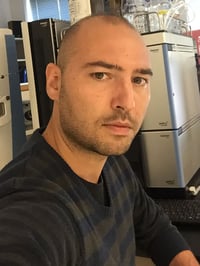Creating 200 billion-plus brand-new red blood cells a day can take a toll on a body. The capacity to replace components charged with the life-sustaining task of carrying oxygen eventually wears out with aging, resulting in health problems, from anemia to blood cancers.
What if we could halt the aging process and maintain young blood cells for life? With blood cells making up a whopping 90% of the body’s cells, it makes sense that keeping them abundant and fit could boost vitality into our golden years.
Now, a group of researchers, including experts at the University of Colorado Anschutz Medical Campus, has discovered ways to do just that – keep the blood manufacturing process flowing. The work, recently published in the journal Nature, could open doors to everything from disease-preventive therapies to better blood banks.

Angelo D'Alessandro, PhD |
Aging throws wrench into blood-making process
“If we manage to keep 90% of the cells in our body young, chances are that much of our body is going to be young,” said Angelo D’Alessandro, PhD, likening the concept to changing the oil in a car.
D’Alessandro, an expert in blood cell research at the University of Colorado School of Medicine, joined the dual-campus study, along with colleagues Monika Dzieciatkowska, PhD, and Julie Reisz Haines, PhD. The woman-led study included Shuxian Dong PhD, and Ana Maria Cuervo, MD, of the Albert Einstein College of Medicine.
Blood cells are responsible for oxygen transport, infection control and many other things scientists are just discovering, D’Alessandro said. But they have a short lifespan – 120 days for red blood cells, and even shorter for other blood cells – and must regenerate continuously throughout life, he said.
“This fascinating phenomenon is made possible by the capacity of hematopoietic stem cells (HSCs) to multiply and differentiate into all the blood cell types, a mechanism that unfortunately can become impaired as we get old. Results can include anemia, when we can’t make enough red blood cells, or blood cancers, when some blood cell precursors go rogue and start multiplying without differentiating,” D’Alessandro said.
International Women's Day: ‘Amazing women in science’ lead blood aging study
The study uncovering ways of making old blood look young again was led by “amazing women in science,” as researcher Angelo D’Alessandro, PhD, noted. Here are two of those women, highlighted in recognition of International Women’s Day (March 8).
– “It was such an honor to be part of the Nature paper, among so many outstanding colleagues from Albert Einstein College of Medicine and the University of Colorado Anschutz Medical Campus. Together, we found that pharmacologically activated CMA has a potential to restore the function of aging HSCs and improve immune function.” – Monika Dzieciatkowska, PhD
– “The most exciting part of this work is that by leveraging complimentary data from these very advanced techniques (metabolomics, proteomics, and very elegant in vivo studies), it is possible to begin uncovering a biological mechanism at the molecular level for understanding how HSCs age and the links between aging and stemness.” – Julie Reisz Haines, PhD
Scientists focus on ‘housekeeping’ mechanism
The researchers targeted chaperone-mediated autophagy (CMA), one mechanism they found responsible for the degradation. Like a housekeeper gone awry, CMA with age can fail in its job of cleaning up damaged proteins and other wastes, sabotaging the HSCs’ capacity to make new, healthy blood cells.
Pinpointing one key protein (LAMP2A) that regulates CMA function whose expression and activity declines with age, the scientists used both genetic, dietary and pharmacological interventions that restored young hematopoiesis (formation of blood cellular components) in old laboratory mice.

Monika Dzieciatkowska, PhD |
“That was one approach: switching back on the gene that gets turned off with age,” D’Alessandro said.
The scientists also showed that a metabolic enzyme (FADS2) involved in fatty acid metabolism loses function with age, reducing healthy blood cell formation. By introducing gamma linolenic acid (GLA), a product of the failing enzyme, in the rodents’ diets, the researchers again improved cell regeneration.
“We showed that a failure in the CMA system results in alterations of lipid metabolism by lack of degradation of age-damaged FADS2 in the stem cells. By switching mice to a diet rich in GLA, we could fix the phenotype. That is, we could make old mice look more like young mice in the capacity to generate new blood cells,” D’Alessandro said.
Potential for reducing disease, cognitive decline
After determining that the CMA dysfunctions in mice mirrored those in 70-plus-year-old humans, the researchers believe their findings could eventually translate into reversing the aging process of HSCs in humans, opening the door to numerous medical therapies.
Previous studies have linked the waste buildup from CMA decline to neurological degenerative diseases, such as Parkinson’s and Alzheimer’s. And past studies of his own have shown that chronic inflammation results in alteration of the blood-regenerating process, D’Alessandro said.
The findings could translate into current research D’Alessandro’s team is conducting with Joaquin Espinosa, PhD, and partners at the Linda Crnic Institute for Down Syndrome at CU Anschutz.
“Individuals with Down syndrome suffer from chronic inflammation, and they have hematopoiesis that is compromised like an old person. So, it’s a similar mechanism that can go wrong,” D’Alessandro said, noting that individuals with Down syndrome also have leukemia and Alzheimer’s rates that rival those of older people.
“Evidence is mounting that links the impaired capacity to make young blood cells in old people to the development of neurodegenerative diseases,” D’Alessandro said, citing another recent Nature study that restored metabolism of myeloid cells, reversing cognitive decline in aging mice.

Julie Reisz Haines, PhD |
Other benefits: better blood banks, vitality for life
Blood regeneration could also have a significant impact on blood donations, as the age of donors has continued to trend up during the past 20 years, D’Alessandro said.
“We have around 15 million units transfused every year in the United States alone. It’s the most common in-hospital medical procedure worldwide after vaccination, and it’s a lifesaving one,” he said, noting that numerous people could benefit, including trauma, surgery, cancer and anemic patients with sickle cell disease or thalassemia.
But most blood donors today are 65 and older.
“Blood from old donors shares some of the characteristics we observed in blood from old mice, such as lower levels of polyunsaturated fatty acids, including GLA. These fatty acids affect the flexibility of blood cell membranes, a factor that regulates the capacity of blood cells to circulate upon transfusion.”
While the researchers may not have found the fountain of youth just yet, D’Alessandro said the discovery could translate to better health well into a person’s senior years.
“While our results may not help people live forever, they may contribute to a healthier life as we get old. While extending the lifespan might still be out of reach, I think that improving our health span is an actionable goal in the next 10 or 15 years.”



